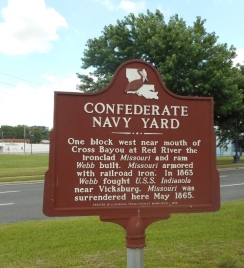Compared to most major campaigns of the Civil War, the Red River Campaign of 1864 is certainly among the least-studied and least understood. Most overview histories of the conflict devote a paragraph or two at most to the entire affair if that much space, and there are only a very small number of books devoted to the campaign in print. Thanks in no small part to the work of Gary D. Joiner, clearly the dean of historians who have written about the Red River Campaign, this rather large but almost comically disastrous combined-forces effort is finally getting its due. Joiner has published two book-length studies of the campaign; One Damn Blunder From Beginning to End: The Red River Campaign of 1864 and Through the Howling Wilderness: The 1864 Red River Campaign and Union Failure in the West. We recently decided to read the second of these works, published in 2006, in preparation for a visit to some of the sites significant to the campaign.

The series of blunders and missed opportunities that was the Red River Campaign reveals it to be ill-conceived, poorly planned, and wretchedly executed. Officially a combined-forces effort on the part of the Union army and navy to capture the regionally-strategic Louisiana capital and war production center of Shreveport, occupy western Louisiana and Texas, and prevent Confederate authorities from sending Trans-Mississippi troops to slow operations in more coveted eastern campaigns, the truth is the affair had political overtones that threatened its effectiveness from the beginning and was plagued by poor decision-making. In 1864 the Red River region featured one of the most productive cotton-producing areas of the Confederacy still in Southern hands, and the politically-ambitious Nathaniel P. Banks, placed in charge of the operation, angled to capture a share of the fiber to fuel the silent mills on his New England homeland and thus advance his political aspirations. That the Union high command acquiesced in the schemes of an inept and unqualified general is bad enough, but the series of errors that resulted in the near capture of the invading force and destruction of the entire naval fleet renders it one of the most infamous campaigns of the war. While Joiner rightly blames Banks for much of the colossal failure of the effort, he shows there was plenty of culpability to go around on both sides, as a seemingly resounding Confederate success in truth was nowhere near complete as it could have been due to strategic failures on the part of the sometimes dysfunctional leadership of the Trans-Mississippi Department.
While we discovered Joiner’s book to be informative and detailed, we also found it to be at points tedious and repetitive. Featuring a rather dry and technical text, the book is more of a campaign study focusing on and evaluating strategy than a simple account of the major events of the campaign. Joiner must be commended for his comprehensiveness nonetheless, discussing seemingly every aspect of the campaign from its planning to its implementation on the ground and rivers of Louisiana and Arkansas, and its repercussions in the region and beyond. The several unique maps produced by the author for the book are of immense benefit to those wishing to follow in the footsteps of the armies, but it must be noted that some are printed so small that they can only be read with difficulty. Indeed, the font of the paperback version of the book—the only version readily available—is small to distraction. We believe that the book might have featured the same number of pages in a more readable font size if the author had not consistently repeated himself, recapping virtually every segment of the campaign within and sometimes again at the end of each chapter. Further, the inclusion of an entire chapter focusing on the findings of the Joint Committee on the Conduct of the War regarding the campaign, discussed in detail throughout the book, strikes us as extraneous to the narrative and might have been a summarized appendix instead.
Despite all these criticisms, the truth is Joiner is hands down the expert in all aspects of the Red River Campaign and if anyone wants to learn more about it, his books need to be on their reading lists. Through the Howling Wilderness is definitely geared more toward those who enjoy evaluating strategy and the famous “what ifs” in the Civil War than a straightforward blow by blow of perhaps the least-chronicled major campaign of the conflict. We suspect most readers looking for an introduction to the campaign should opt to first read his supposedly more strictly military engagement focused One Damn Blunder.
JMB/CPW













